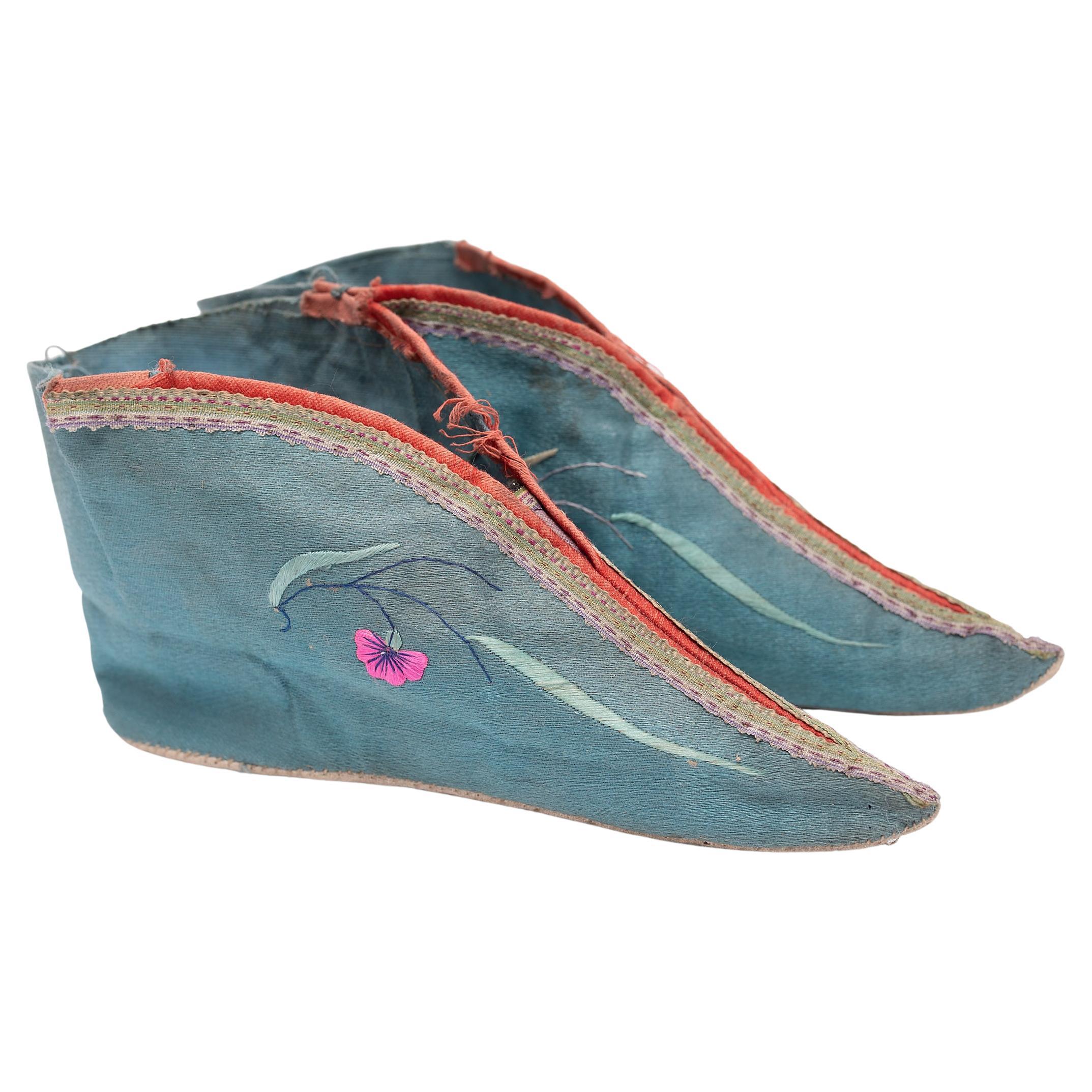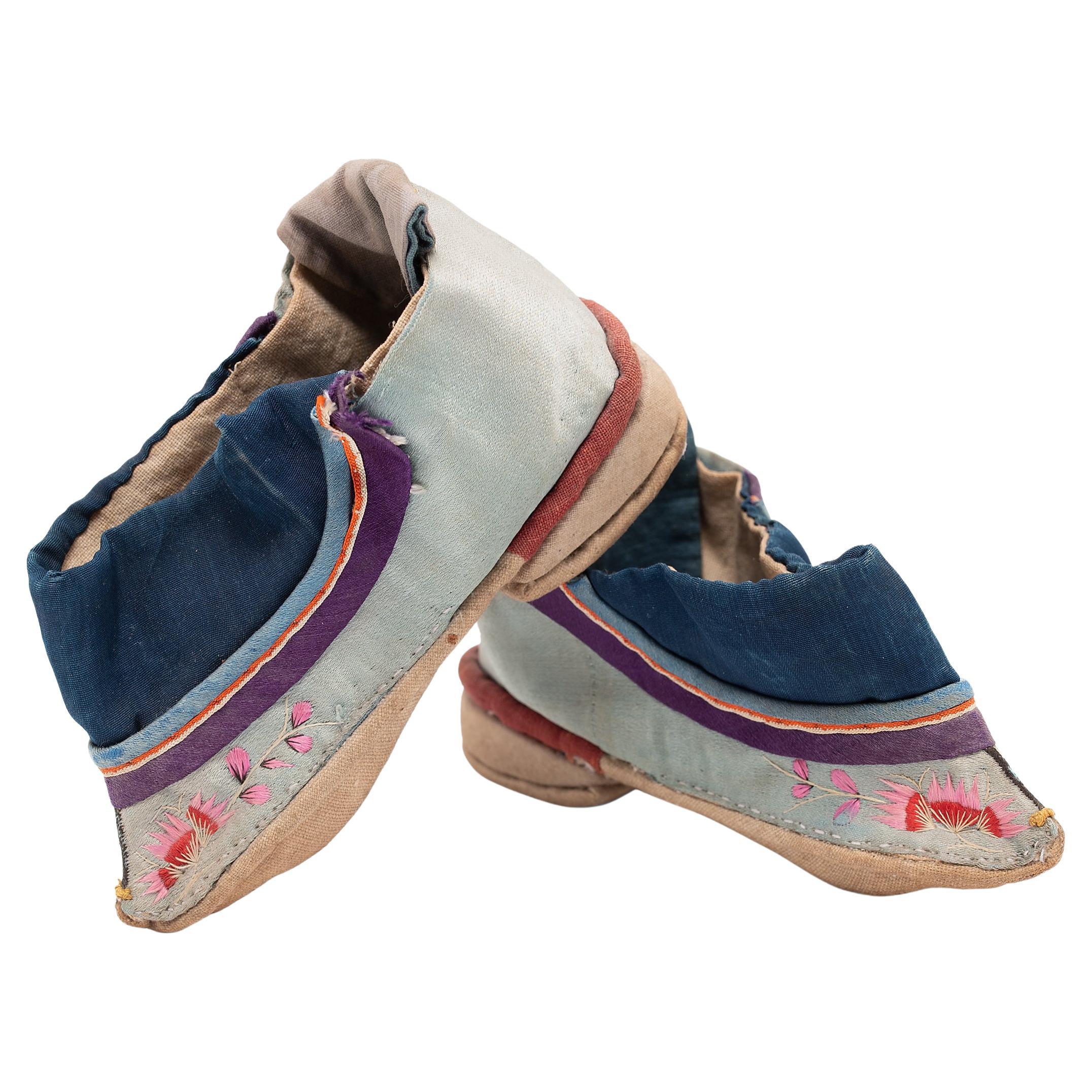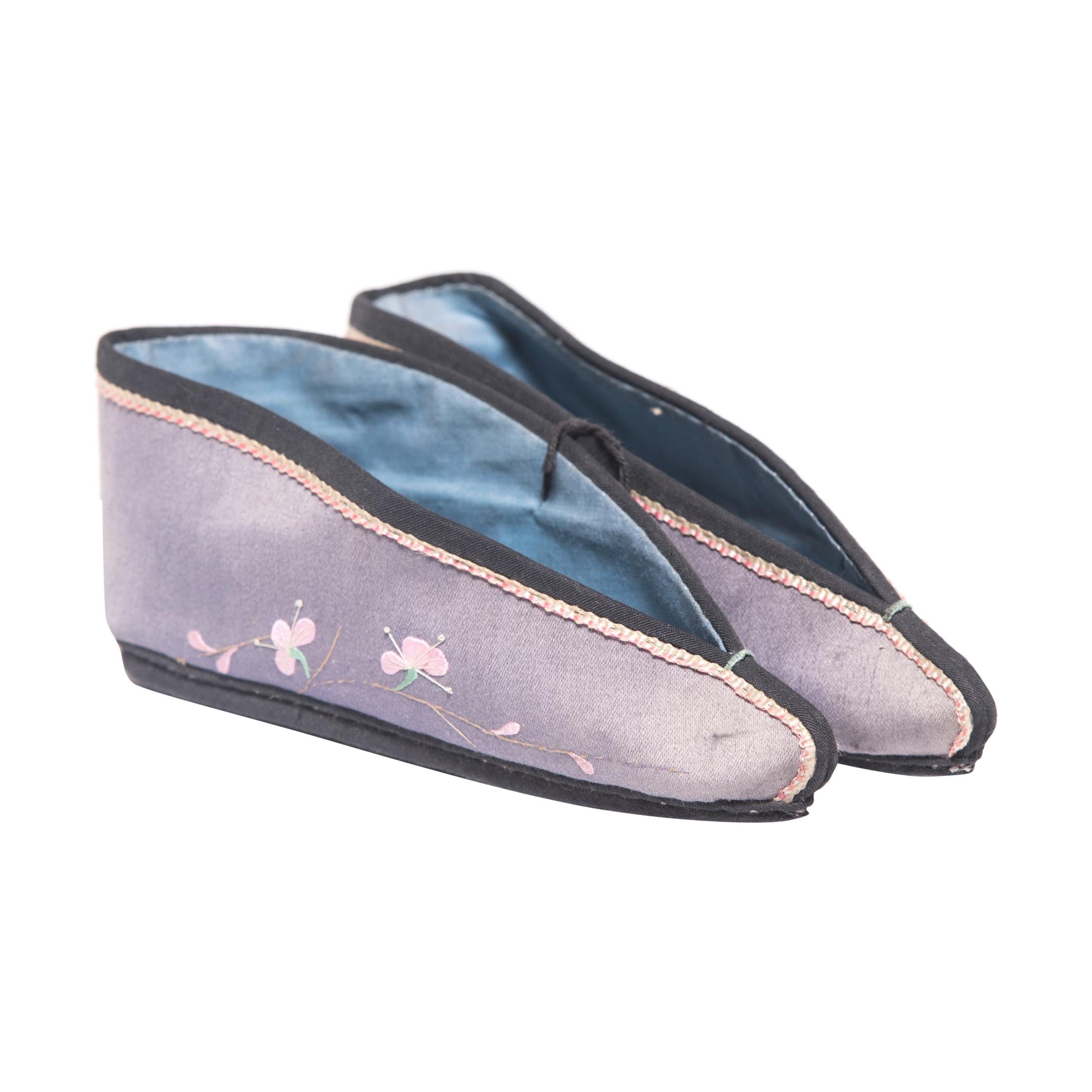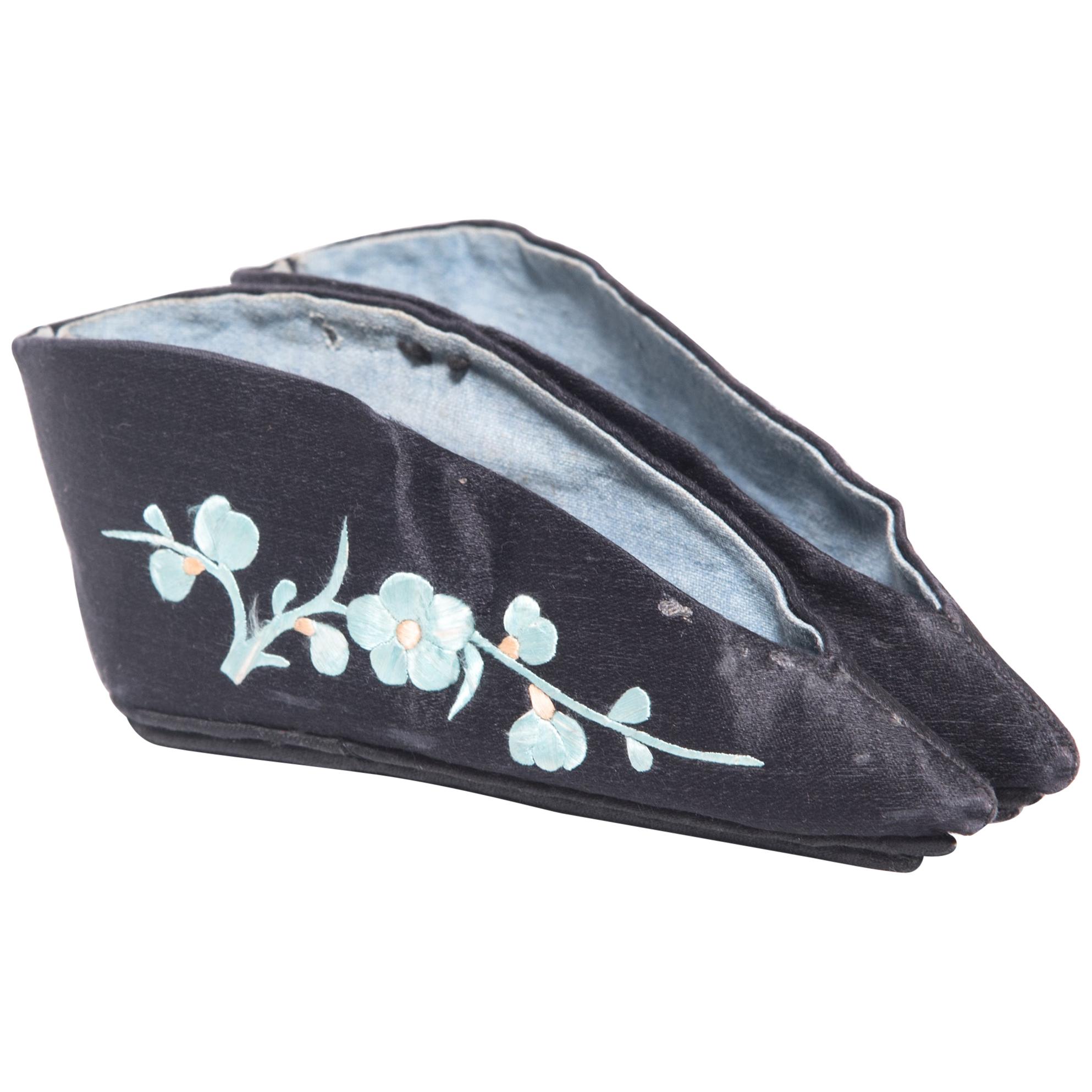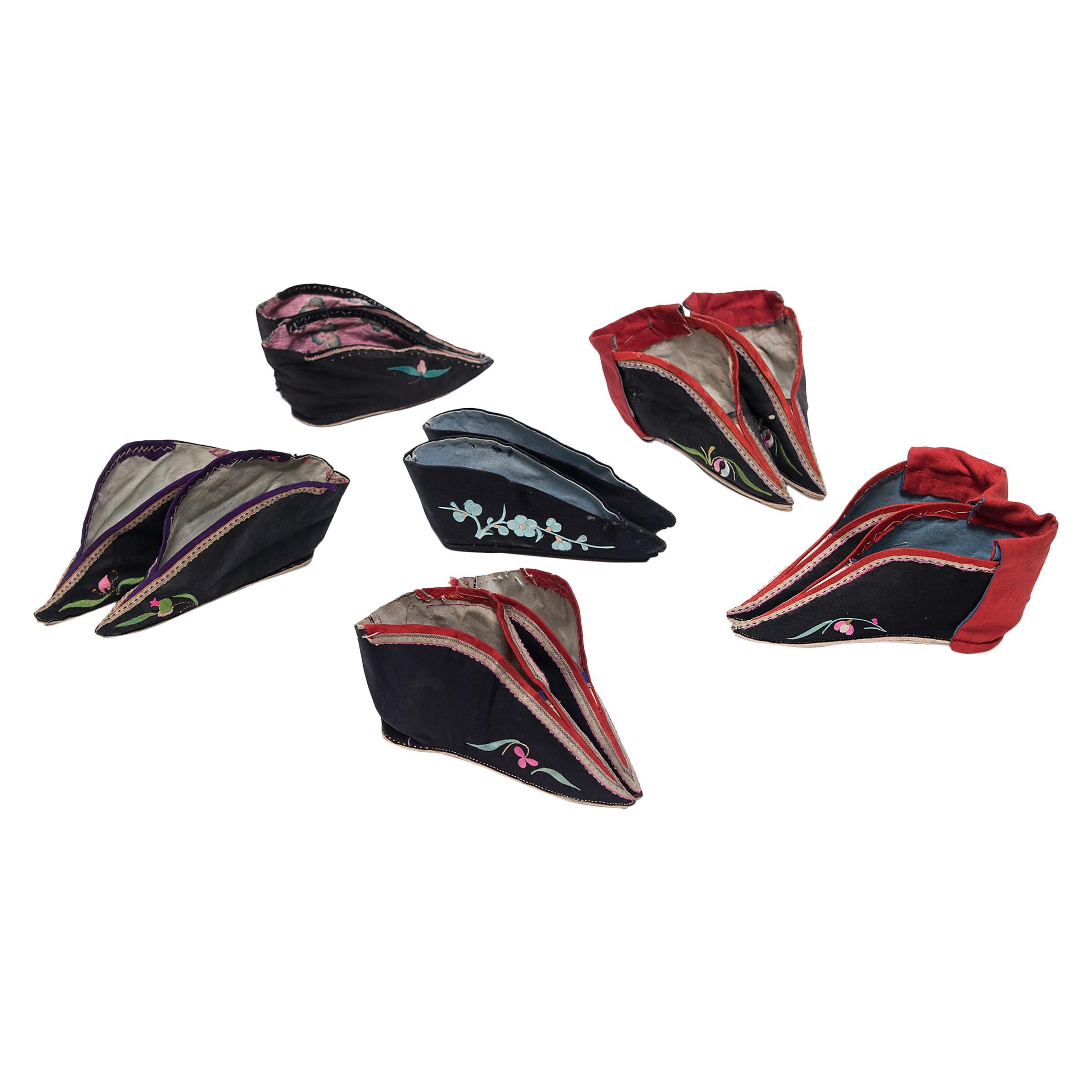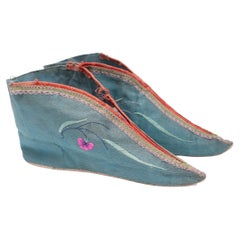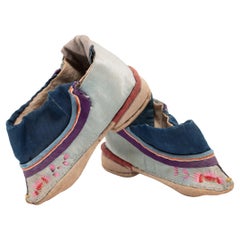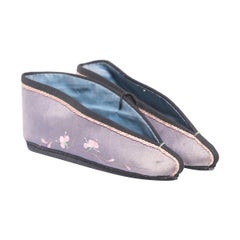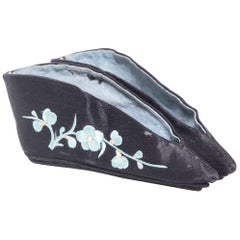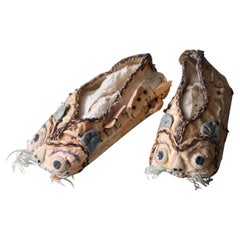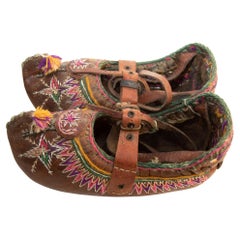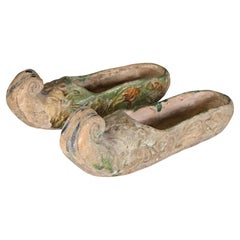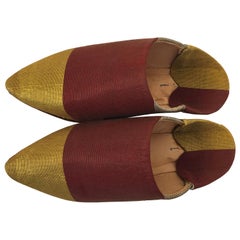Items Similar to Pair Chinese Double Luck Lotus Slippers, c. 1850
Want more images or videos?
Request additional images or videos from the seller
1 of 7
Pair Chinese Double Luck Lotus Slippers, c. 1850
$188
£142.53
€164.30
CA$264.77
A$293.61
CHF 154.27
MX$3,587.39
NOK 1,930.12
SEK 1,811.75
DKK 1,226.53
About the Item
These pointed silk slippers are beautifully embroidered with colorful bats and golden coins, symbols of happiness and good luck, and were shaped to resemble a lotus bud to enhance one's bound feet. A practice that began in the Tang dynasty and reached the height of its popularity during the Qing dynasty, foot binding was a painful process intended to make a woman's feet as small as possible by restricting bone growth from an early age. The smaller the feet the more attractive and erotic they were, giving elite women a mark of elegance and a distinctive, albeit tortured, gait of small, light steps. These beautifully preserved lotus slippers give us a glimpse into this curious practice and the complicated role fashion played in gender identity throughout China’s past.
- Dimensions:Height: 2.5 in (6.35 cm)Width: 5 in (12.7 cm)Depth: 7 in (17.78 cm)
- Style:Qing (Of the Period)
- Materials and Techniques:
- Place of Origin:
- Period:
- Date of Manufacture:circa 1850
- Condition:Wear consistent with age and use. Minor fading.
- Seller Location:Chicago, IL
- Reference Number:Seller: PR0013XX1stDibs: LU820018550632
About the Seller
5.0
Platinum Seller
Premium sellers with a 4.7+ rating and 24-hour response times
Established in 1997
1stDibs seller since 2006
1,710 sales on 1stDibs
Typical response time: 1 hour
- ShippingRetrieving quote...Shipping from: Chicago, IL
- Return Policy
Authenticity Guarantee
In the unlikely event there’s an issue with an item’s authenticity, contact us within 1 year for a full refund. DetailsMoney-Back Guarantee
If your item is not as described, is damaged in transit, or does not arrive, contact us within 7 days for a full refund. Details24-Hour Cancellation
You have a 24-hour grace period in which to reconsider your purchase, with no questions asked.Vetted Professional Sellers
Our world-class sellers must adhere to strict standards for service and quality, maintaining the integrity of our listings.Price-Match Guarantee
If you find that a seller listed the same item for a lower price elsewhere, we’ll match it.Trusted Global Delivery
Our best-in-class carrier network provides specialized shipping options worldwide, including custom delivery.More From This Seller
View AllPair of Chinese Silk Lotus Slippers, c. 1850
Located in Chicago, IL
These dainty, pointed slippers, made of blue silk and embroidered with pink flowers, were shaped to resemble a lotus bud and enhanced the diminutive shape of bound feet. A practice that began in the Tang dynasty and reached the height of its popularity in the Qing dynasty, foot binding was a painful process intended to make a woman's feet as small as possible by restricting bone growth from an early age. The smaller the feet the more attractive and erotic they were, giving elite women a mark of elegance and a distinctive - albeit tortured - gait of small, light steps. These embroidered silk lotus slippers...
Category
Antique Mid-19th Century Chinese Qing Textiles
Materials
Cotton, Silk
Pair of Chinese Silk Lotus Slippers, c. 1850
Located in Chicago, IL
These dainty, pointed slippers, made of cotton and silk embroidered with pink flowers, were shaped to resemble a lotus bud and enhanced the diminutive shape of bound feet. A practice that began in the Tang dynasty and reached the height of its popularity in the Qing dynasty, foot binding was a painful process intended to make a woman's feet as small as possible by restricting bone growth from an early age. The smaller the feet the more attractive and erotic they were, giving elite women a mark of elegance and a distinctive - albeit tortured - gait of small, light steps. These silk lotus slippers...
Category
Antique Mid-19th Century Chinese Qing Historical Memorabilia
Materials
Cotton, Silk
Chinese Lilac Lotus Slippers with Plum Blossoms, c. 1850
Located in Chicago, IL
These pointed silk slippers, beautifully embroidered with pink plum blossoms, were shaped to resemble a lotus bud and enhanced the diminutive shape of b...
Category
Antique Mid-19th Century Chinese Qing Historical Memorabilia
Materials
Cotton, Silk
Chinese Black Silk Lotus Slippers with Plum Blossoms, c. 1850
Located in Chicago, IL
These pointed slippers, beautifully embroidered with light blue plum blossoms on black silk, were shaped to resemble a lotus bud and enhanced the diminutive shape of bound feet. A practice that began in the Tang dynasty and reached the height of its popularity during the Qing dynasty, foot binding was a painful process intended to make a woman's feet as small as possible by restricting bone growth from an early age. The smaller the feet the more attractive and erotic they were, giving elite women a mark of elegance and a distinctive - albeit tortured - gait of small, light steps. These beautifully preserved lotus slippers...
Category
Antique Mid-19th Century Chinese Qing Historical Memorabilia
Materials
Silk
Set of Six Chinese Bound-Foot Lotus Slippers, circa 1850
Located in Chicago, IL
Each of these pointed slippers, crafted of beautifully embroidered silk, were shaped to resemble a lotus bud and enhanced the diminutive shape of bound feet. A practice that began in the Tang dynasty and reached the height of its popularity during the Qing dynasty, foot binding was a painful process intended to make a woman's feet as small as possible by restricting bone growth from an early age. The smaller the feet the more attractive and erotic they were, giving elite women a mark of elegance and a distinctive - albeit tortured - gait of small, light steps. These beautifully preserved lotus slippers...
Category
Antique Mid-19th Century Chinese Qing Historical Memorabilia
Materials
Cotton, Silk
Chinese Charm Token Shoe with Compartment, c. 1850
Located in Chicago, IL
Originally tucked in a pocket as a charm, this tiny shoe was kept close at hand as a talisman for marital happiness. Meticulously carved from wood, the shoe is decorated with a double happiness symbol, the traditional symbol for conjugal bliss. A lovely Valentine’s Day or anniversary gift, the charm has a compartment ready to be filled with a note or small gift...
Category
Antique Mid-19th Century Chinese Qing Sculptures and Carvings
Materials
Pine
You May Also Like
19th Century Chinese Paper & Silk Embroidered Child's Shoes Slippers
Located in Lowestoft, GB
A delicate and decorative pair of baby shoes, hand crafted with embroidered silk and paper, often worn to celebrate the Chinese New Year.
19th century in age, we age related losses ...
Category
Antique Early 19th Century Chinese Textiles
Materials
Silk, Paper
Antique Pair of Charogh Ethnic Shoes from Turkey
Located in Moreno Valley, CA
Antique Pair of Charogh Ethnic Shoes from Turkey.
These collectible Museum Kurdish shoes are known as charoghs and were made in Khorasan province in north western Turkey.
Hand-crafte...
Category
Antique Late 19th Century Turkish Folk Art Textiles
Materials
Leather
Pair of Sancai Glazed Tang Dynasty Ceramic Slippers
Located in Kilmarnock, VA
A remarkably rare and unusual pair of sancai-glazed slippers dating from the Tang Dynasty (618–907 CE). These were likely created as funerary mingqi—tomb objects made to accompany th...
Category
Antique 15th Century and Earlier Chinese Tang Figurative Sculptures
Materials
Clay
Moroccan Silk Slippers Ethnic Shoes
Located in Moreno Valley, CA
These Moroccan silk slippers are handmade to perfection the inside sole is crafted of soft leather.
These shoes are the traditional Moroccan shoes, all hand made with hand-sewn leather sole.
You won't want to take the Moroccan babouches off your feet!
Moroccan slippers...
Category
20th Century Moroccan Bohemian Textiles
Materials
Silk
$95 / set
Precious pair of Harem mules - Ottoman Empire, late 18th century
Located in Toulon, FR
Late 18th century, early 19th century
Ottoman Empire
A precious and very old pair of mules for the harem in the Ottoman Empire. Rigid curved shape covered with pink silk satin with a...
Category
Late 18th Century Turkish Shoes
Antique Leather Mughal Shoes with Gold Embroidered
Located in Moreno Valley, CA
A pair of rare late 19th century hand stitched and hand tooled leather shoes with hand embroidered with gilt metallic threads.
Amazing antique Mughal gold...
Category
Early 20th Century Indian Moorish Textiles
Materials
Metallic Thread
More Ways To Browse
Blue Lotus
Double Happiness
Fabric Circa 1850
Chinese Double Happiness
Lotus Slippers
Antique Chinese Slippers
Hand Crank
Indian Shield
Antique Furniture Richmond
Antique Stamp Machines
Antique Telephones
National Register Antique
Mid Century Christmas Tree
Mercury Glass Ornaments
1920s Christmas
Antique Rifles
Franklin Furniture Company
Masonic Furniture
